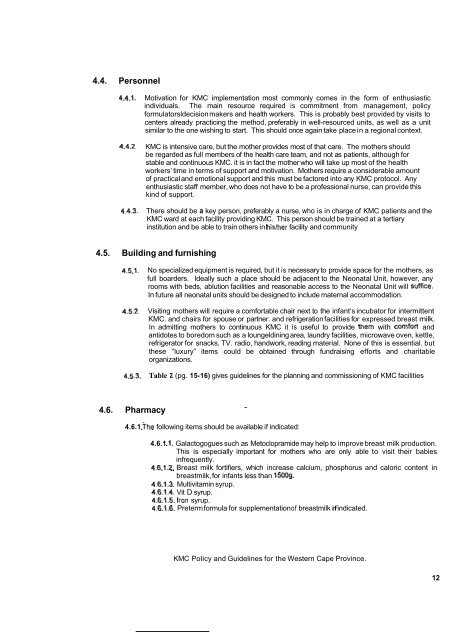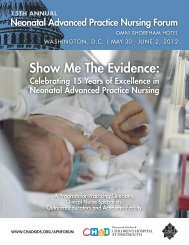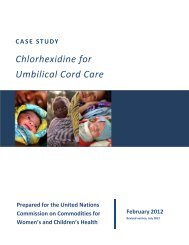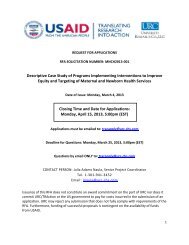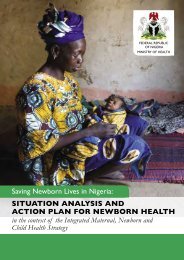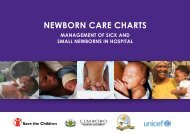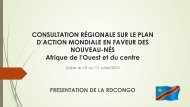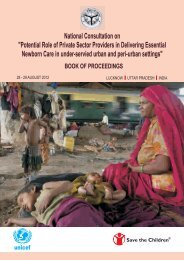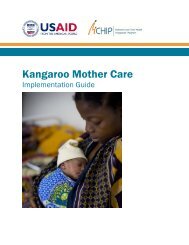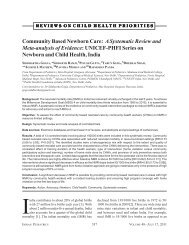Kangaroo Mother Care Policy/Guidelines - Western Cape Government
Kangaroo Mother Care Policy/Guidelines - Western Cape Government
Kangaroo Mother Care Policy/Guidelines - Western Cape Government
Create successful ePaper yourself
Turn your PDF publications into a flip-book with our unique Google optimized e-Paper software.
4.4. Personnel<br />
4.4.1. Motivation for KMC implementation most commonly comes in the form of enthusiastic<br />
individuals. The main resource required is commitment from management, policy<br />
formulatorsldecision makers and health workers. This is probably best provided by visits to<br />
centers already practicing the method, preferably in well-resourced units, as well as a unit<br />
similar to the one wishing to start. This should once again take place in a regional context.<br />
4.4.2.<br />
4.4.3.<br />
KMC is intensive care, but the mother provides most of that care. The mothers should<br />
be regarded as full members of the health care team, and not as patients, although for<br />
stable and continuous KMC. it is in fact the mother who will take up most of the health<br />
workers’ time in terms of support and motivation. <strong>Mother</strong>s require a considerable amount<br />
of practical and emotional support and this must be factored into any KMC protocol. Any<br />
enthusiastic staff member, who does not have to be a professional nurse, can provide this<br />
kind of support.<br />
There should be a key person, preferably a nurse, who is in charge of KMC patients and the<br />
KMC ward at each facility providing KMC. This person should be trained at a tertiary<br />
institution and be able to train others in hislher facility and community<br />
4.5. Building and furnishing<br />
4.5.1. No specialized equipment is required, but it is necessary to provide space for the mothers, as<br />
full boarders. Ideally such a place should be adjacent to the Neonatal Unit, however, any<br />
rooms with beds, ablution facilities and reasonable access to the Neonatal Unit will suffice.<br />
In future all neonatal units should be designed to include maternal accommodation.<br />
4.5.2.<br />
Visiting mothers will require a comfortable chair next to the infant‘s incubator for intermittent<br />
KMC. and chairs for spouse or partner. and refrigeration facilities for expressed breast milk.<br />
In admitting mothers to continuous KMC it is useful to provide them with comfort and<br />
antidotes to boredom such as a loungeldining area, laundry facilities, microwave oven, kettle,<br />
refrigerator for snacks, TV. radio, handwork, reading material. None of this is essential. but<br />
these “luxury” items could be obtained through fundraising efforts and charitable<br />
organizations.<br />
4.5.3. Table 2 (pg. 15-16) gives guidelines for the planning and commissioning of KMC facilities<br />
4.6. Pharmacy<br />
-<br />
4.6.1 .he following items should be available if indicated:<br />
4.6.1 .I. Galactogogues such as Metoclopramide may help to improve breast milk production.<br />
This is especially important for mothers who are only able to visit their babies<br />
infrequently.<br />
4.6.1.2. Breast milk fortifiers, which increase calcium, phosphorus and caloric content in<br />
breastmilk, for infants less than 15009.<br />
4.6.1.3. Multivitamin syrup.<br />
4.6.1.4. Vit D syrup.<br />
4.6.1.5. Iron syrup.<br />
4.6.1.6. Preterm formula for supplementation of breastmilk if indicated.<br />
KMC <strong>Policy</strong> and <strong>Guidelines</strong> for the <strong>Western</strong> <strong>Cape</strong> Province.<br />
12


